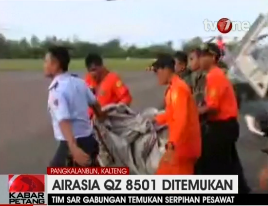
(Reuters) — Search and rescue teams carried debris, presumed to be from missing Air Asia flight QZ8501, onto land from a helicopter on Tuesday (December 30) evening.
Indonesian rescuers searching for the missing plane, carrying 162 people, pulled bodies and wreckage from the sea off the coast of Borneo on Tuesday.
The navy said 40 bodies had been recovered as dusk fell. The plane has yet to be found and there was no word on the possibility of any survivors.
The Airbus A320-200 lost contact with air traffic control early on Sunday (December 28) during bad weather on a flight from the Indonesian city of Surabaya to Singapore.
Relatives of those on board were gathered at a crisis center in Surabaya, and broke down in tears on hearing the news. Some collapsed and were helped away, said a Reuters reporter.
About 30 ships and 21 aircraft from Indonesia, Australia, Malaysia, Singapore, South Korea and the United States have been involved in the search of up to 10,000 square nautical miles.
The plane, which did not issue a distress signal, disappeared after its pilot failed to get permission to fly higher to avoid bad weather because of heavy air traffic, officials said.
It was travelling at 32,000 feet (9,753 metres) and had asked to fly at 38,000 feet, officials said earlier.
Pilots and aviation experts said thunderstorms, and requests to gain altitude to avoid them, were not unusual in that area.
The Indonesian pilot was experienced and the plane last underwent maintenance in mid-November, the airline said.
The aircraft had accumulated about 23,000 flight hours in some 13,600 flights, according to Airbus.
Online discussion among pilots has centred on unconfirmed secondary radar data from Malaysiathat suggested the aircraft was climbing at a speed of 353 knots, about 100 knots too slow, and that it might have stalled.







